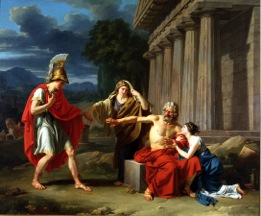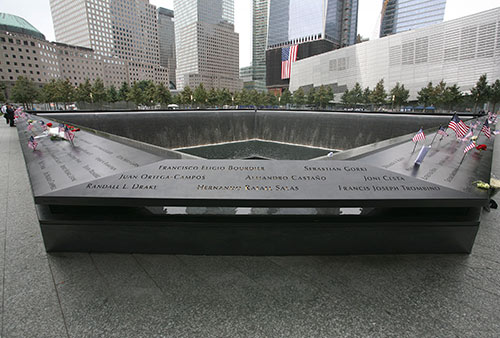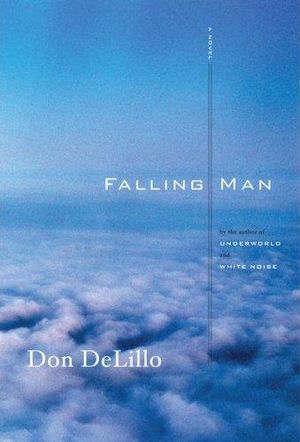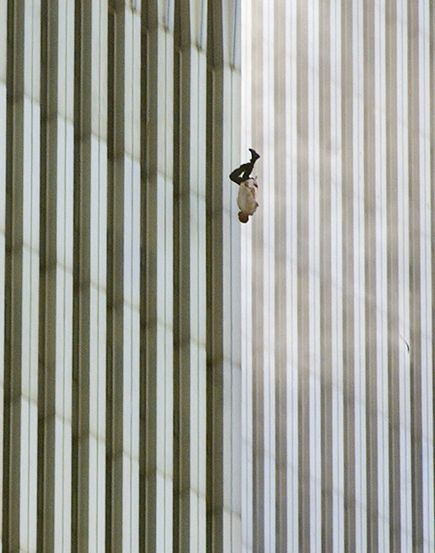Death, Catastrophe, and the Significance of Tragedy
by Jennifer Ballengee
published May 2014
At the close of Sophocles’ Oedipus at Colonus, Oedipus dies, surrounded by a crowd yet alone, publicly yet in secret, and witnessed by only the Athenian king and hero Theseus, who may or may not be watching. The death is an important event for Athens, as prophecy holds that Oedipus’ dead body will bring great power to the city where he dies. Yet the catastrophe of Oedipus’ death is marked by a tension between turning toward and away, recognizing the event and missing it at the same time. This NANO note will examine the tension between representation, memorial, and the catastrophe of death that emerges in the space of tragedy, as the problem arises in two quite different works: Oedipus at Colonus, a fairly typical fifth-century Greek tragedy, and Falling Man, Don DeLillo’s novel that, in its attempt to address the events of 9/11, reflects in form and subject matter many of Aristotle’s terms of tragic representation. As Aristotle indicates in Poetics, in tragedy, the “thought [dianoia]” of the drama may be expressed in speech [lexis] that doesn’t refer to it directly (1456b7-8). Moreover, in the representation of tragedy, speech works in conjunction with physical performance to convey the meaning of the performative event. In this sense, it is not the intent of this note to engage with the recent proliferation of work in “performance theory.” Rather than being concerned with an imagined exchange between audience and actor, this study examines how the supplementary relationship of gesture and speech in tragedy disrupts the public/private distinction, and how this articulation effects and enables the public memorialization of death. Thus juxtaposing Sophocles’ fifth-century drama with Don DeLillo’s 2007 novel, this paper will consider the representation of death as an event whose catastrophic, and somewhat mysterious, collision of the public and the private lends it its tragic significance.
Aristotle suggests in the Poetics that tragedy, which belongs to the arts of mimesis or representation, remains distinct from other mimetic arts such as epic poetry, dithyramb, or music in that it utilizes actors on a stage along with verse and rhythm in order to convey its meaning. As his well-known formula describes:
Tragedy is a representation of a serious, complete action which has magnitude, in embellished speech, with each of its elements [used] separately in the [various] parts [of the play]; [represented] by people acting and not by narration; accomplishing by means of pity and terror the catharsis of such emotions. (1449b24-28)
The body of the actor corresponds to the meaning of language; gestures have the potential to be both mimetic and deictic. In tragedy, this passage suggests, the “doing” of actors takes the place of the reporting of narrative language. Tragedy represents its meaning upon a stage before an audience by means of bodily actions supplemented by spoken words.
This “doing” is, of course, mimesis, which for Aristotle is broadly the source of our pleasure in tragedy (and presumably other representative arts). Mimesis, he explains, is the art of imitation, of reproducing in art what exists in nature. Yet, as Jacques Derrida has noted (in “White Mythology”), this pleasure of recognition corresponds necessarily to marking the absence of the represented object: “The mimeme is neither the thing itself nor something totally other. Nothing will upset the law of this pleasure according to the economy of the same and of difference, not even—especially not—the horror, ugliness, and unbearable obscenity of the imitated thing, as soon as it remains out of sight and out of reach, off stage” (240). There is to mimesis, then, both mimicry and memory (the similarity of mimeomai and mimnysko—to recall to memory—seems to hint toward a connection, even though they’re not demonstrably cognate); the skill is in imitating what is not there, but what presumably was once there and is now passed or passing away.
This correspondence of imitation and memory is clearly evident in classical Greek tragedy, which quite literally situates itself in times past in order to reflect upon the present. In Oedipus at Colonus, whose plot is driven by horrific events that happened years earlier in Oedipus’ life, this past/present reflection is clearly at work. At the opening of the play, Oedipus, old and blind, has arrived with the help of his daughter Antigone at the sacred grove of the Eumenides on the outskirts of Colonus, a suburb of Athens. Prophecy has indicated that this is where he is to die, giving this grove and Athens, in general, the protective powers that are to emanate from his dead body. He calls for the Athenian hero Theseus to protect him and bear witness to his death. As they wait for his arrival, Oedipus testifies to the chorus about the horrible sufferings—“beyond mortal limits” (106), “unspeakable” (265)—that he has endured in life. Indeed the marvelous power that will emanate from his body in death is directly connected—an antidote, of sorts—to the terrible pain he has endured in life. Thus the place of his death will function as a heros: a sanctuary whose powers derive from the remembered sufferings endured by the dead body buried at that spot. In lieu of a verbal testament to his life of torment will stand the physical presence of his gravesite, containing hidden within it the corpse, empowered by its tortuous past.
Mindful of this prophecy, Oedipus prays at the beginning of the play for this death, figured as a catastrophe [katastrophēn] to arrive: “Come, goddesses, in accordance with Apollo’s sacred word, grant to me a passage and a conclusion [katastrophēn] to my life...” (l. 101-3). Once Theseus arrives, the event of Oedipus’s death is indeed set in motion.

Ultimately, Theseus, Oedipus’ daughters Antigone and Ismene, a few attendants, and a messenger accompany Oedipus offstage, with Oedipus designating that only Theseus will be allowed actually to witness his death; Oedipus notes that for the prophecy to take effect, the exact location of his death must remain hidden to all others (1521-4)—rather, the grove itself will take on the memorializing powers of his terrible life, once it has passed away there.
As the thunder of Zeus peals overhead, Oedipus’ body disappears forever (either disappearing into heaven or being swallowed completely by the earth). Yet oddly, the epic hero who alone among humans has permission to witness Oedipus’ passing actually fails to see the singular event, according to the messenger who reports the details of Oedipus’ death to the chorus (and the watching audience):
And when we had departed, after a short time we turned around, and could see that the man [Oedipus] was no longer present, and the king [Theseus] was shading his eyes, holding his hand against his head, as though some terrible, terrifying thing, unbearable to see, had been presented. (1647-52)
In an odd twist of dramatic performance, Sophocles represents the catastrophe of Oedipus’ death by means of a messenger who is forbidden to see the occurrence and thus must report upon what he saw of the only one who was allowed to see, Theseus—who himself fails to see because the sight presented is too terrible for seeing. In lieu of representation, then, in the place of what cannot be staged, the messenger presents a description of the event to the witnessing audience (both on and offstage).
The speech of the messenger (that is, the reporter, the angelos) quoted above suggests a complicated relation between mimesis and language in tragedy. As I noted earlier, Aristotle indicates that the purpose of the performance of speech would disappear if the thought spoken by the actor were not essential: “[f]or what would be the task of the speaker, if the necessary elements were apparent even without speech?” (1456b7-8 9 (translation modified)). Derrida, again from “White Mythology,” likewise suggests that this passage emphasizes the function of rhetoric in tragedy: “If there were no difference between dianoia and lexis, there would be no space for tragedy” (232-3). For Derrida, the need for lexis, the rhetorical presentation of the thought of the work, indicates a significant difference—between speech and thought—that creates the space for the performance of tragedy. In tragedy, the thought of the work can be expressed in speech that does not refer to it directly—that indeed stands in place of, takes the place of, dianoia or thought.
Yet what happens when speech fails? To return to Oedipus at Colonus, in the speech of Antigone that follows the messenger’s report quoted above, Sophocles presents yet another barrier to understanding Oedipus’ death, or, in other words, remembering his life by means of the event of his death:
Alas, alack! It is for us, it is for us to lament in all fullness for the accursed blood from our father that is in us, unhappy pair; our father for whom we endured continual pain, and at the last we shall carry away from him things beyond reason that we have seen and suffered. (1670-6)
For Antigone and Ismene, what is left at the end of Oedipus’ life is the curse he has handed down to them, pains which surpass reason (they are alogista) but which they have seen and suffered. What eludes speech can nevertheless be seen and felt; Antigone laments here the task that lies in her future: the curse of mourning what cannot be expressed precisely in language. It seems that here speech works in conjunction with physical performance in the tragedy; through mimesis, Sophocles stages a public mourning that gestures at the limits of expression. In this sense, the physical gestures that perform ritual mourning indicate the tragic loss that eludes representation in speech.
These two responses to Oedipus’ death present two divergent hurdles to representing the “event” of death. On the one hand, the instant of Oedipus’ death cannot be seen by any individual, even the epic hero designated to witness it. Nevertheless, the “event” is reported by a witness in terms of its not having been seen: the messenger’s words, delivered to the audience of Theban elders and the audience of spectators, take the place of the actual moment of death. Yet this narrative account fails to correspond entirely—to represent truthfully—the significance of Oedipus’ death. This difference arises again in the second passage. For, as Antigone laments, the meaning of Oedipus’ death—that is, what the mourning of his passing and therefore of his past, would convey—stands beyond reason; it cannot be reasonably communicated to others but remains to the daughters only in what they themselves have seen and suffered because of their father’s life. Bridging the difference between lexis and dianoia, the tragic actor performs upon the stage not only before his audience, but for his audience, the public, who thus serve as a witness to the staged “event” of death. The combination of utterance and physical gesture that comprises the messenger’s report and the sisters’ mourning memorializes the event of Oedipus’ death to the extent that the sacred grove may acquire the potent protection offered by his tormented life, embodied by his hidden corpse. Likewise, this combination of words and gesture performs and simultaneously remembers his death as tragedy, for the audience seated in the theater. In this sense, the public performance stands in for the private catastrophe that resists being witnessed, or escapes representation.
The idea of public mourning was brought to the fore recently in the United States with the creation of the National September 11 Memorial and Museum, which opened on the site of the former World Trade Center Towson in New York City on September 12, 2011 (the dedication ceremony was September 11).

The memorial strives to recognize the individual death within the mass by means of the inclusion of individual names of those killed in the event, carved into “bronze parapets” set on the site of the former towers. Yet nevertheless the title of the memorial—the National September 11 Memorial and Museum—makes each of those individual deaths into a national cause enfolded in a date that offers metonymy in the place of specificity. There is of course much more to say about the public function of the 9/11 memorial in New York, which I will address in another project. My purpose in including it briefly here is in order to foreground in its contemporary milieu the problem of the representation of death as a public, tragic event—and by means of the same problem of loss and memorialization (the attacks of 9/11) that DeLillo addresses in his novel.
As Derrida argued in an interview with Giovanna Borradori conducted a few weeks after the “actual event” of 9/11/01:
We do not in fact know what we are saying or naming in this way: September 11, le 11 septembre, September 11. The brevity of the appellation (September 11, 9/11) stems not only from an economic or rhetorical necessity. The telegram of this metonymy—a name, a number—points out the unqualifiable by recognizing that we do not recognize or even cognize, that we do not yet know how to qualify, that we do not know what we are talking about. (86 (author’s italics))
In linguistic reflection of the function of the physical memorial, September 11, or 9/11, stands in the place of the individual deaths that befell each victim on that day. In a combination of the physical and the verbal, the memorial structure and the inscription of names, the date, and the title of the memorial itself combine to represent and remember the tragic event for the witnessing public. As Derrida argues, however, a displacement occurs here. The tragic event performed by the memorial takes the place of the events of September 11, 2001: in lieu of the moment of death or deaths, in the place of the missing bodies, stands the performance.
Indeed, within the interview, Derrida goes on to suggest our ability to specifically mourn these deaths is precisely what was wounded in that terrorist action:
Is, then, what was touched, wounded, or traumatized by this double crash only some particular thing or other, a “what” or a “who,” buildings, strategic urban structures, symbols of political, military, or capitalist power, or a considerable number of people of many different origins living on the body of a national territory that had remained untouched for so long? No, it was not only all that but perhaps especially, through all that, the conceptual, semantic, and one could even say hermeneutic apparatus that might have allowed one to see coming, to comprehend, interpret, describe, speak of, and name “September 11”—and in so doing to neutralize the traumatism and come to terms with it through a “work of mourning.” (93)
If one were to diagnose American culture’s frequent return to the events of 9/11, one would find an apt reflection of Derrida’s argument here: traumatized, we repeat and return, failing at each attempt to give voice to the specificity of the catastrophic event by naming it, by representing it in memory or in memorialization.
This difficulty drives a number of novels that have emerged since the events of 9/11, many of which draw out perhaps the most individual aspect of the masses of deaths on that day: emerging from the crowds of bodies that fell together inside the buildings and inside the planes were the individual bodies of those who took their deaths into their own hands, and jumped from the windows of the Towers. One particularly powerful example of representing falling bodies is the film by Jules and Gédéon Naudet, French documentary film makers who, in making a film about but New York City firefighters, ended up producing the most complete filmic representation of the events. Their documentary 9/11 first aired by CBS in 2002. As their cameras pan up through the ceiling of the atrium between the buildings, they catch the ominous thumping sounds of bodies hitting the roof, falling from high above in the towers. The jarring sounds of these bodies might not have been so specific if the Naudets had followed CBS’s demand that they edit out many of the sounds of impact; the television station was concerned that hearing so many would be upsetting to the television audience.
In its title and content, Don DeLillo’s novel Falling Man addresses this phenomenon most directly.

The central character, Keith Neudecker, is at work in the North Tower when the plane hits, though we hear of his experience of this only through flashbacks, the most developed of which comes at the end of the novel. In general, the novel examines how the attacks of 9/11, including his own experience after the trauma, haunt those around him. Indeed, the wounding of all of the characters by the experiences of 9/11 seems to manifest itself in a cobbled inability to occupy a future, as much as with a pre-occupation with the memory of what transpired on that day. This is, for Derrida, the specific product of the trauma produced by terrorism: “Traumatism is produced by the future, by the to come, by the threat of the worst to come, rather than by an aggression that is ‘over and done with’” (Autoimmunity 97). The threat of terrorism—or “traumatism,” as Derrida describes it here—is as much in imagining what will or might happen as in remembering what has passed.
Such traumatism transforms consciousness: it disrupts our sense of space and time. DeLillo’s novel thus opens with the sentence, “[i]t was not a street anymore but a world, a time and space of falling ash and near night” (3). For the New Yorkers featured in DeLillo’s novel, the attacks of September 11, 2001, destabilize the basic categories of experience. Indeed the phenomenal experience of being seems cast into doubt for Keith and his fellow survivors in this novel. Thus when Keith, still covered in blood and ash, shows up at the door of his estranged wife Lianne after the towers’ collapse and then stays on, assuming the gestures of their former life together, she muses that he seems only half-present, as if he “was not quite returned to his body yet” (59). Indeed, she goes on to wonder if anything at all can ever be “ordinary” again: “Maybe there was a deep fold in the grain of things, the way things pass through the mind, the way time swings in the mind, which is the only place it meaningfully exists” (105).
DeLillo focalizes this disorientation in his depiction of a range of survivors, who wander, wraith-like, through the text. When Keith returns to his old apartment, which lies so close to the towers that he must pass into a cordoned-off zone and talk his way through several police checkpoints in order to return for a few of his things, he pauses to watch the volunteers working in the still-smoking ruins and muses: “The dead were everywhere, in the air, in the rubble, on rooftops nearby, in the breezes that carried from the river. They were settled in ash and drizzled on windows all along the streets, in his hair and on his clothes” (25). Hidden in rubble, or destroyed beyond recognition, the dead are both everywhere and nowhere in particular at once. In contrast, next to him stands a man with a cell phone, clearly in a similar predicament, who repeats into his phone “I’m standing here”—a phrase Keith then echoes when in his own abandoned building: “I’m standing here”—as if the phrase was itself a performative speech-act that could call into existence a life that seems irretrievably passed away.
In his depiction of Keith’s appearance when he appears on Lianne’s doorstep in the late afternoon of September 11, DeLillo suggests that the necessity of calling one’s being into existence in such a manner is perhaps prompted by the manner in which the attacks not only destroyed bodies, but actually comingled them. When Lianne finds him there, she almost immediately moves to clean his wounds before taking him to the hospital. With surprise, she realizes that most of the blood she’s wiping away clearly belongs to others. Later, when a male nurse at the hospital treats Keith’s wounds, he explicitly describes this phenomenon, framing it in terms specific to a certain type of terrorist attack:
In those places where it happens, the survivors, the people nearby who are injured, sometimes, months later, they develop bumps, for lack of a better term, and it turns out this is caused by small fragments, tiny fragments of the suicide bomber’s body. The bomber is blown to bits, literally bits and pieces, and fragments of flesh and bone come flying outward with such force and velocity that they get wedged, they get trapped in the body of anyone who’s in striking range. Do you believe it? A student is sitting in a café. She survives the attack. Then, months later, they find these little, like pellets of flesh, human flesh that got driven into the skin. They call this organic shrapnel. (16)
In this case, the corpse is not merely hidden, but actually obliterated by being randomly disseminated into the environment; bits are actually embedded in the flesh of others. With this, DeLillo depicts in physiological terms the problem of mourning that Derrida describes: our inability to know or to name the catastrophic loss of those moments on the morning of September 11 becomes figured in these passages by the literal disembodiment of the victims. Specifically framing the problem here in terms of terrorist attacks, DeLillo draws attention to the manner in which terrorism by nature illuminates a particular issue of public mourning. Terrorist attacks are necessarily unexpected: indeed this quality of surprise and (initial) anonymity provokes terror. As such, the terrorist destruction of life makes overt the problem of death that Oedipus’ death also signifies: the moment of death must always be missed. This lacuna destabilizes the narrative arc of individual life such that not only the past but also the future is called into question. Public mourning, or the memorial, attempts to assert a logic of social (or human) significance upon individual life and death. Yet the attempt to know or name the past moment that has been missed must necessarily fall short.
In DeLillo’s novel, this haunting experience of failure (prompted by the missed moment of death and figured by the missing, unidentifiable, or indistinguishable body) is embodied by a performance artist character called Falling Man, whose unpredictable performances of falling turn into actual theater the general feelings of dread that have been prompted by the traumatic terrorist event. Each performance follows the same exact pattern, a strictly aestheticized repetition: the body, clothed in a business suit, dangles upside down, arms at his sides and one leg bent at the knee. Thus recreating a well-known photo by Richard Drew of a man jumping from the Towers on 9/11, the performance of Falling Man prompts in every case discomfort and even anger in his spontaneous audience: “There were people shouting up at him, outraged at the spectacle, the puppetry of human desperation, a body’s last fleet breath and what it held. It held the gaze of the world . . . There was the awful openness of it, something we’d not seen, the single falling figure that trails a collective dread, body come down among us all” (33).

When Lianne encounters one of his performances up close, she is disturbed most of all by the pose: “There was something awful about the stylized pose, body and limbs, his signature stroke. But the worst of it was the stillness itself” (168). Later in the novel she finds his obituary in the paper, learning ultimately that his heart condition meant that he was slowly killing himself with these performances; moreover he had planned to make his last performative fall without the safety harness.
While the Falling Man performance artist depicted by DeLillo is purely fictional, the photo that the character imitates is not. Widely distributed just after the attacks on the Trade Center, the image depicted a man in a white shirt and black trousers, plummeting in freefall headfirst down the side of the tower. With the character Falling Man, DeLillo hints at what may be so disturbing, and striking, about the bodies that leapt from the Towers on that day: for the length of the fall, life and death are suspended, the significance of both held in abeyance by the body’s base materiality. As Lianne learns in her research on the Falling Man artist: “Free fall is the fall of a body within the atmosphere without a drag-producing device such as a parachute. It is the ideal falling motion of a body that is subject only to the earth’s gravitational field” (221).
Repeatedly, Falling Man recreates the disruption of a body destroying itself by its own means. In the gesture of falling, Falling Man reminds his audience, again and again, of a rupture in the continuity of life and death, a continuity enabled by our sense of life (and death) as a narrative movement: past, present, and future; memory, the event, and what is to come. As such, the Falling Man performs repeatedly the nature of terror itself, for the audience within the novel and for DeLillo’s reading audience. “In the first place,” Derrida asks, “what is terror? What distinguishes it from fear, anxiety, and panic?” (Autoimmunity 102). Caught up in the narrative significance of life, fear, anxiety, and panic are concerned with the dangers that await us in the future, around the corner, the unknown or known threats lurking in shadows ahead. Rupturing the past and the future at once, terror disrupts the significance of life and death, and thus the possibility of significance at all: it exceeds the imagination.
The character Falling Man performs this breakdown repeatedly and spontaneously, serving as a tragic reminder of the rupture of terror, communicating to a witnessing audience the significance of the bodies that fell from the tower. Yet in serving this memorial purpose, his public performance takes the place of the secret catastrophe of the specifically individual death, which continues to remain just beyond view, outside of meaning.
Works Cited
Aristotle. Poetics. Trans. Richard Janko. Indianapolis: Hackett, 1987. Print.
Borradori, Giovanna. “Autoimmunity: Real and Symbolic Suicides—A Dialogue with Jacques Derrida.” Philosophy in a Time of Terror: Dialogues with Jürgen Habermas and Jacques Derrida. Chicago: U of Chicago P, 2003. 85-136. Print.
DeLillo, Don. Falling Man. New York: Scribner, 2008. Print.
Derrida, Jacques. “White Mythology.” Margins of Philosophy. Trans. Alan Bass. Chicago: U of Chicago P, 1982. 207-72. Print.
9/11. Dir. James Hanlon, Gédéon Naudet, Jules Naudet. CBS. 2002. DVD.
Sophocles. Oedipus at Colonus. Trans. Hugh Lloyd-Jones. Cambridge, MA: Harvard UP, 1994. Print.
Figures:
3. “Cover to the first edition.” Falling Man. Wikipedia. 16 May 2007. Web. 27 Sept. 2013. JPEG.

